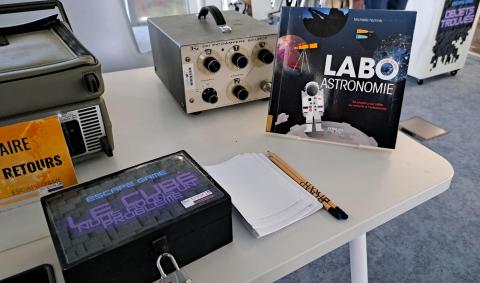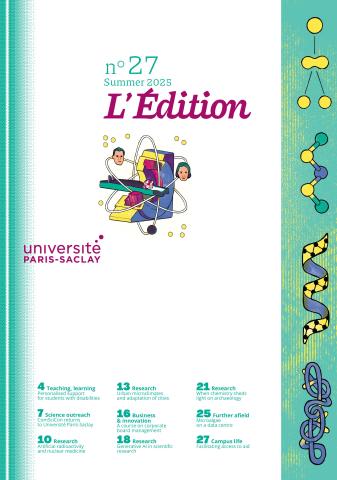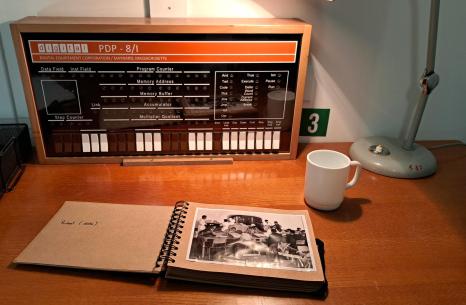
Escape games: When Université Paris-Saclay plays along
This article was originally published in L'Édition n°27.
More than just immersive entertainment, escape games are proving to be powerful educational tools for making science more accessible and highlighting scientific resources and heritage. Such benefits have been demonstrated by two examples created at the Université de Versailles Saint-Quentin-en-Yvelines (UVSQ) and the Orsay Faculty of Sciences at Université Paris-Saclay.
It was supposed to be a quiet Friday at the control centre. Then came the bad news: astronaut Thomas Pasquier was lost in space! He was drifting far from Earth, with only thirty minutes of oxygen left. But where exactly had the astronaut gone? The centre's team was under pressure. They had to locate his spacecraft as quickly as possible and bring him back before it was too late. Fortunately, Thomas Pasquier had left some clues behind. Now it was up to the team to find them... Thirty minutes later, mission accomplished! ThomasPasquier was safe!
Back in the real world. That was all fictional. We weren't in a control centre, but in Le Cube, an innovative learning room housed in the Saint-Quentin University Library (BU) at the Université de Versailles Saint-Quentin-en-Yvelines (UVSQ). Last March, it was the setting for a brand new escape game developed by the BU, entitled Le Cube... We have a problem!.
After medicine and fake news, now space
Escape games are time-limited challenges in which players must complete a mission as a team. To do so, the team is locked in an immersive room where they must find hidden clues and solve puzzles. Over the past decade, escape games have become a hugely popular leisure activity. So it's no surprise that the community of Université Paris-Saclay has embraced the trend. However, these games are much more than just immersive experiences. They can also be highly effective educational tools, as shown by the three escape games already created at the Saint-Quentin university library.
The first game, developed in 2023, involved escaping the clutches of a mad scientist using their knowledge of medicine. The second, launched in 2024, took place in an Arctic research station and explored the topics of fake news and climate change. "Each time, the aim is to present scientific puzzles while encouraging players to explore library services, such as database searches," explains Emmanuelle Roger, Coordinator of Undergraduate and Graduate User Courses at the St-Quentin University Library. Over a hundred players have already tried their hand at these first two games.
For this third instalment, "we want to promote our services and document databases, while highlighting a theme linked to the university," details Florence Gabriel, Document Manager in Law, Political Science and Sociology at the library. Therefore, the design team chose to set the story in space, drawing inspiration from the research of the Atmospheric Space Observations Laboratory (Latmos- Univ. Paris-Saclay/National Centre for Scientific Research, CNRS/UVSQ/SorbonneUniv.).
Once the project was approved, "one team from the library developed the puzzles using the library's documentation, while another team created the setting for the room and borrowed equipment from Latmos," adds Florence Gabriel. The result: a carefully crafted scenario set amidst scientific equipment and books on space science.
One hour to power up an electron accelerator
At the Orsay Faculty of Sciences at Université Paris-Saclay, the success of the escape games is also sparking inspiration. In the basement of the Institute of Physical Chemistry (ICP – Univ. Paris-Saclay/CNRS), a former laboratory now transports visitors back to the 1980s, casting them in the role of scientists. Their mission: to startup the Fébétron, a powerful electron accelerator, as quickly as possible. "The aim was to explore science while showcasing the faculty's scientific heritage in a more entertaining way for younger audiences," explains Romuald Drot, who co-designed the Mission Fébétron escape game with Laura Pignon from the faculty's Scientific Communication, Outreach and Heritage Service (COMPAS). The storyline, like the location, was chosen deliberately, directly referencing decades of research at the institute, which is today home to the ELYSE electron accelerator.
It took many months of work to craft the puzzles and sets for the game. The lecturer explains: "For the puzzles, we drew on our own knowledge and clues we'd already seen in other escape games. During the mission, we also wanted to give people the chance to interact with heritage scientific instruments". Vintage furniture sits alongside genuine instruments, which the novice scientists must operate to succeed in their mission and find the all-important Fébétron button in time. Immersion is guaranteed. But no spoilers here! Open to everyone, the escape game is regularly presented at events such as the Science Festival and Heritage Days. And it's not alone.
Le Cube and Mission Fébétron are just two examples of the entertaining creations regularly developed by the teams of Université Paris-Saclay, its associate member institutions and its constituent faculties and institutes specialising in educational innovation and science outreach. So what will your next mission be?
Learn more:

This article was originally published in L'Édition n°27.
Find out more about the journal in digital version here and on Calameo.
For more articles and topics, subscribe to L'Édition and receive future issues:


